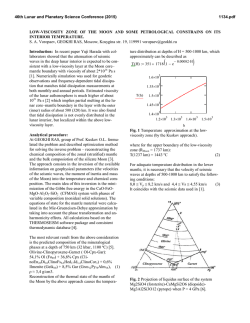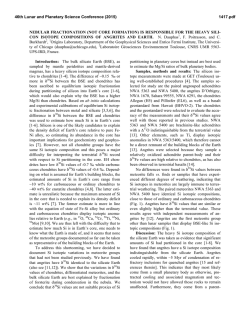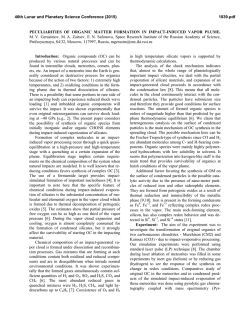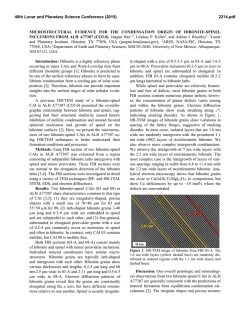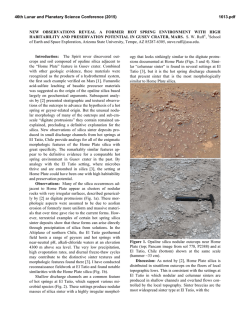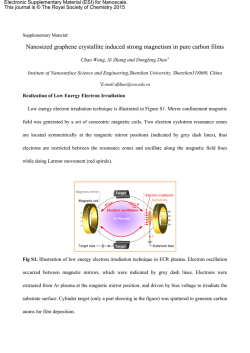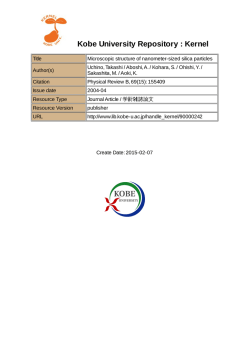
documento 504893
46th Lunar and Planetary Science Conference (2015) 2192.pdf CONDENSATION COEFFICIENT OF FORSTERITE IN THE H2–H2O–Mg2SiO4 SYSTEM. S. Tachibana1 and A. Takigawa2, 1Department of Natural History Sciences, Hokkaido University, N10W8 Sapporo, Hokkaido 0600810, Japan. e-mail: [email protected], 2Department of Earth and Planetary Science, Kyoto University, Kitashirakawa Oiwake-cho, Kyoto 606-8502, Japan. Introduction: Equilibrium condensation calculations provide a set of stable minerals under a certain physical and chemical condition, condensation does not necessarily occur in equilibrium in time-variant circumstellar systems, where pressure, temperature, and gas chemistry vary with time. It is of much importance to understand the kinetic aspect of dust formation processes, especially the vapor growth kinetics of dust. There have been many experimental studies on dust formation under non-equilibrium conditions. We have been particular about evaporation and condensation experiments of dust-analogue minerals [e.g., 1, 2] under the conditions as close as possible to real circumstellar conditions such as pressure, temperature, and gas chemistry because processes that control dust formation could be different under different physicochemical conditions. The vapor growth flux (J) of major dust-analogue minerals such as forsterite (Mg2SiO4), metallic iron, and corundum (Al2O3) is expressed with the HertzKnudsen equation as a function of the partial pressure of condensing gas species (p), the equilibrium vapor pressure of the gas species on the condensed matter (peq) and temperature (T) [3]: J = (αcp – αepeq) / (2πMRT)1/2, (1) where M is the molar weight of the gas species, R is the gas constant, and αc and αe are the condensation and evaporation coefficients, respectively, ranging from 0 to 1 to represent kinetic hindrances for surface atomistic reactions. Although the evaporation coefficient αe of forsterite in vacuum and in hydrogen gas has been well determined [e.g., 2], condensation kinetics of forsterite (Mg2SiO4) under low-pressure conditions has not yet been investigated in detail in spite of its importance. In this study, following our preliminary results [4, 5], we report a quantitative estimate of the condensation coefficient αe for vapor growth of forsterite under protoplanetary disk-like conditions in the system of H2– H2O–forsterite. Experiments: An infrared vacuum furnace was used in this study, consisting of a silica glass tube (~300 mm in length and 38 mm in diameter) connected to a pumping system (a turbo-molecular pump and a rotary pump) and two infrared heating systems (Thermo-Riko IR298UT). The furnace was continuously evacuated during experiments. A mixed gas of hydrogen and water vapor was flowed into the system at a controlled rate to keep a pressure constant. Synthetic forsterite powder in an iridium crucible was heated as a gas source. A part of evaporated gases were condensed on a substrate of platinum mesh located at a cooler region in the chamber (26 mm from the gas source). The iridium crucible and the substrate were placed in a silica glass tube (26 mm in diameter) to prevent condensation of evaporated forsterite onto the wall of the outer tube. The substrate temperature was monitored by a type-R thermocouple. The pressure and temperature conditions during the experiment were close to those of protoplanetary disks. The total pressure of the system was kept at 5.6 Pa (5.6 x 10-5 bar) by adjusting the pumping rate and the gas flow rate, and the substrate temperature were 1235 K with a fluctuation of ±5-10 K. The gaseous H2O/H2 ratio was set at 0.015, which was ~15 times larger than the solar H2O/H2 ratio. In order to evaluate the SiO/H2 ratio in the flux onto the substrate and the supersaturation ratio, the condensed fraction onto the wall of the inner silica tube was evaluated with silica glass plates placed in the tube. The experimental duration was 49.5 hours. Condensates were observed with a field-emission scanning electron microscope (FE-SEM; JEOL JSM 7100F) installed at Department of Natural History Sciences, Hokkaido University, and their chemical composition and crystallinity were analyzed with energy dispersive X-ray spectroscopy (EDS; Oxford X-MaxN 20) and electron backscattered diffraction (EBSD; HKL CHANNEL 5). Results and Discussion: Characterization of condensates. The platinum mesh was fully covered with sub-micron to micronsized condensates. Chemical compositions of condensates were consistent with stoichiometric forsterite. A variety of EBSD patterns corresponding to crystalline forsterite were obtained from the condensates. We thus conclude that the condensates are a thin film of polycrystalline forsterite as in [3, 4]. Gas chemical composition and supersaturation ratio. The mean free path of gas molecules under the present experimental condition is less than 1 mm, and 46th Lunar and Planetary Science Conference (2015) the evaporated forsteritic gas and the ambient H2–H2O gas are expected to be well mixed. The silica glass tube used as a vacuum chamber may act as a sink of evaporated gases due to condensation onto the glass wall, and the condensed fraction on the wall was estimated from the weight gain of silica glass plates placed inside the inner silica glass tube. Considering the fraction condensed onto the wall, the gaseous SiO/H2 ratio in the flux onto the substrate was obtained to be 5.5 x 10-7 that corresponds to 7.7 x10-3 of the solar SiO/H2 ratio. The supersaturation ratio is defined here as the ratio between the incoming flux of SiO onto the surface of the substrate and the ideal evaporation flux of forsterite at the substrate temperature (pSiO = 0 and αe = 1 in Eq. (1); peq / (2πMRT)1/2). The incoming flux of SiO to the surface of substrate is estimated from the weight loss of the gas source (p / (2πMRT)1/2), and the ideal evaporation flux of forsterite in the Mg2SiO4–H2–H2O system is obtained thermodynamically. Based on these fluxes, the supersaturation ratios (S) for the present experiment at 1235 K was estimated to be 230. Growth kinetics of forsterite. Based on the incoming flux of SiO onto the substrate and the ideal evaporation flux, the condensation coefficient of forsterite (αc) was evaluated to be 0.038 ± 0.005 at 1235 K and S = 230 with the assumption of αc = αe. 2192.pdf The condensation coefficient at 1235 K is well consistent with the evaporation coefficient for forsterite in hydrogen gas [2] and is smaller than that of metallic iron (ac ~ ae ~ 1) [1]. The difference in αc and αe for metallic ion and forsterite may be attributed to the difference in atomic bonds in metallic iron (metallic bonds) and silicates (ionic and/or covalent bonds). This difference implies that the growth of forsterite dust, for instance AOAs in chondrites, occurs less efficiently than that of metallic iron dust in circumstellar environments although they have similar equilibrium condensation temperatures. References: [1] Tachibana S. et al. (2011) Astrophys. J., 736, doi:10.1088/0004-637X/736/1/16. [2] Takigawa A. et al. (2009) Astrophys. J. Letters, 707, L97–L101. [3] Hirth J. P. & Pound G. M. (1963) Condensation and Evaporation, Nucleation and Growth Kinetics. Pergamon Press. [4] Tachibana S. & Takigawa, A. (2014) LPS XXXXV, Abstract #1226. [5] Tachibana S. & Takigawa, A. (2014) Proc. "The Life Cycle of Dust in the Universe: Observations, Theory, and Laboratory Experiments", PoS(LCDU2013)046.
© Copyright 2026
